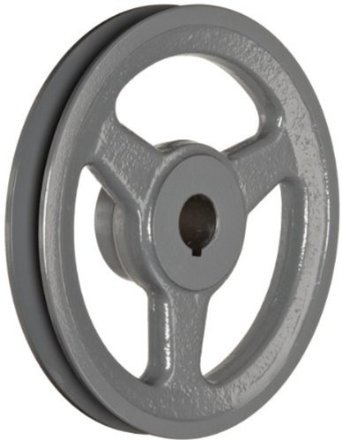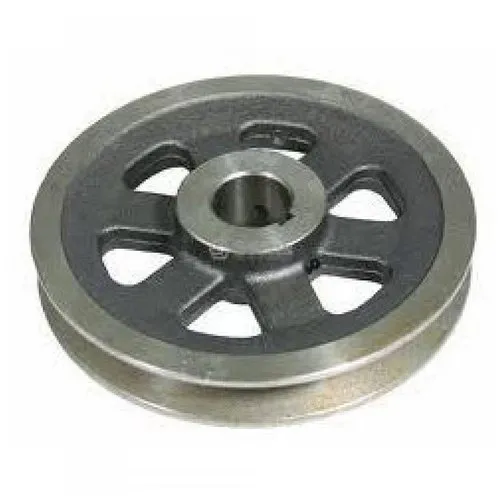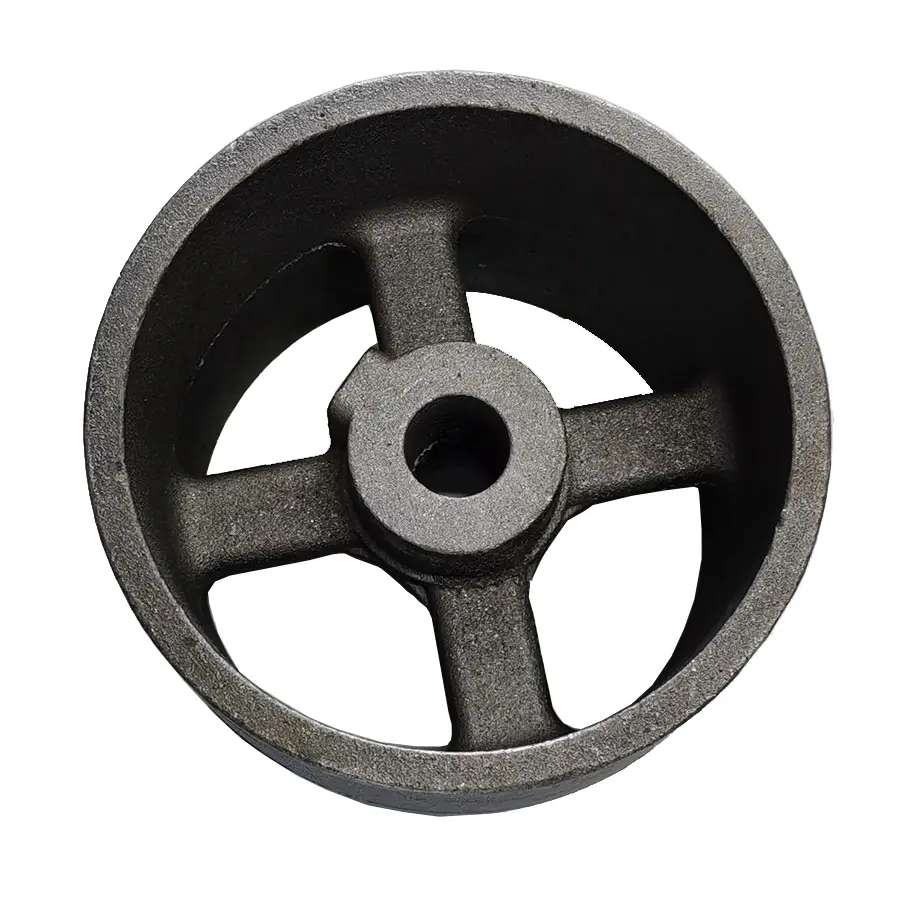Product Description
1B170 1C250 1B250 Cast iron ceramic glazing line Pulley
1. Material: Cast iron GG25, Ductile iron,grey iron
2. Process: machining – phosphating
3. Size:1C230,1C250,1C170,1B250,1B230
Specifications
Various Types of Pulley GG20/GG25/GG30/V-Belt Pluuey
1.Produce as drawings
2.on time delivery
3.ISO,CCC Reliable qualit
Various Types of Pulley GG20/GG25/GG30/V-Belt pulley
Specifications:
Process: casting-machining-palstics spraying-packaging
Technical: sand casting
Material: China-HT200/HT250/HT300 Germery-GG20/GG25/GG30
Dimension: as customer’s request
Casting level: CT10-CT11
Surface roughness: Ra25
Packaging: wooden cases or as customer’s drawings
Surface treatment: shot blasting, plastic spraying, paint spraying
Equipment: cupola, electric furnace
Weight: 0.5kg-100kg
Surface colour: plastic spraying RAL2004/black paint/ antirust paint
Inspection:
In-house and third partyUniversal
All the products are strictly inspected by the operators and skilled QC
inspection tools: hardness tester, height ruler
Production Procedure:
Drawings→Mould developing→Raw casting→Sandblasting→Rough machining or finish machining→Surface treatment→Inspection→Packing→Delivery strictly
We can produce the pulleys according to the drawings and samples provided by the customers with excellent quality and competitive price.
As an experienced casting manufacturer, we assure you the quality! Our products are through careful inspection, and our quality is high and reliable which have been achieved cutomers’ satisfaction!
If you are interested in our products, please do not hesitate to contact us!
|
HangZhou Jiangdashengye Trade co.,ltd. |
|
|
OEM SERVICES |
|
|
Service |
Drawings or samples processing/OEM/ODM service provided |
|
Produce Process |
Drawings→ mould making →raw casting → sandblasting →rough machining or finish machining →surface treatment →product checking→ packing →delivering |
|
Casting Material |
Cast Iron, Grey Iron, Ductile Iron,Carbon Steel, Stainless steel, Alloy steel, |
|
Standard |
ISO, GB, ASTM, DIN, JIS |
|
Equipment |
melting furnace, centrifugal casting machines coated CHINAMFG machine CNC machines turning machines grinding machines milling machines drilling machine punching machines laser carving machine |
|
Surface treatment |
Heat treatment, Polishing, Sand blasting, Painting, Electro-plating, Chemical Plating, and other machining processing. |
|
Inspection Equipments |
Spectrum analysis instrument, Metallurgical analysis, Tensile strength tester, Hardness tester, Roughness tester, deflection tester, Impact test machine, Projector, Altimeter, Scale Micrometer, pressure tester, etc. |
|
Delivery |
Sample sent to customer by air. Large quantity products delivered to customer by sea from xingang,China |
|
Payment terms |
L/C at sight or 30% T/T as deposit and balanced 70% to pay before |
v pulley, v belt pulley, v groove pulley, v groove belt pulley, taper lock pulley, taper lock v belt pulley, taper lock bushing pulley, taper lock pulleys / taper bore pulley, large v belt pulley, double v belt pulley, cast iron v belt pulley belt pulley, variable speed v belt pulleys, v belt pulley split pulley, cast iron v belt pulley
V belt pulley specifications:
1) European standard:
a) V-belt pulleys for taper bushings: SPZ, SPA, SPB, SPC; up to 10 grooves
b) Adjustable speed V-belt pulleys and variable speed pulleys
c) Flat belt pulleys and conveyor belt pulleys
2) American standard:
a) Sheaves for taper bushings: 3V, 5V, 8V
b) Sheaves for QD bushings: 3V, 5V, 8V
c) Sheaves for split taper bushings: 3V, 5V, 8V
d) Sheaves for 3L, 4L or A, and 5L or B belts: AK, AKH, 2AK, 2AKH, BK, BKH,2BK, 2BKH, 3BK
e) Adjustable sheaves: poly V-pulley, multi-pitch H, L, J, K and M
3) Bore: pilot bore, finished bore, taper bore, bore for QD bushing
4) Surface finish: paint, phosphating, zinc plated
5) Material: cast iron, ductile iron, nylon, aluminum
6) Made according to drawings and/or samples, OEM inquiries welcomed
Now we send photo of our production as follows:
/* January 22, 2571 19:08:37 */!function(){function s(e,r){var a,o={};try{e&&e.split(“,”).forEach(function(e,t){e&&(a=e.match(/(.*?):(.*)$/))&&1
| Size: | 1c250 |
|---|---|
| Size2: | 1c230 |
| Size3: | 1b270 |
| Size4: | 1b250 |
| Name: | Casting and Machining Belt Pulley |
| Transport Package: | Wooden Packing |
| Samples: |
US$ 3.5/Piece
1 Piece(Min.Order) | |
|---|
| Customization: |
Available
| Customized Request |
|---|

What is the role of cast iron pulleys in the operation of agricultural machinery?
Cast iron pulleys play a vital role in the operation of agricultural machinery, contributing to the efficient functioning of various agricultural processes. They are used in different types of agricultural equipment and perform specific functions that are crucial for farm operations. Here’s a detailed explanation of the role of cast iron pulleys in the operation of agricultural machinery:
- Power Transmission: Cast iron pulleys are employed in agricultural machinery to facilitate power transmission. They act as a mechanical link between the power source, such as an engine or motor, and the driven components of the equipment. By connecting the power source to the machinery’s moving parts, the pulleys enable the transfer of rotational motion and torque, allowing the equipment to perform its intended functions.
- Belt and Chain Drives: Cast iron pulleys are commonly used in belt and chain drive systems in agricultural machinery. They provide the means to transmit power from the source to the driven components through flexible belts or chains. The pulleys are designed with grooves or teeth that engage with the belt or chain, ensuring a secure connection and efficient power transfer. The selection of the appropriate pulley size, groove configuration, and belt/chain type is crucial to match the power requirements and optimize the machinery’s performance.
- Mechanical Advantage: Cast iron pulleys can be utilized to create mechanical advantage in agricultural machinery. By employing pulley systems with different diameters, the speed and force applied to the driven components can be adjusted. This allows farmers to optimize the machinery’s performance based on the specific tasks at hand. For example, pulley systems can be designed to increase the output speed of certain equipment or provide greater pulling force for heavy-duty operations.
- Belt Tensioning: Maintaining proper belt tension is essential for the effective operation of agricultural machinery. Cast iron pulleys are used in tensioning systems to ensure the belts remain tight and properly engaged with the pulley surfaces. Tensioning pulleys are designed to apply the necessary force to keep the belts taut, preventing slippage and ensuring efficient power transmission. Proper tensioning helps optimize the machinery’s performance, minimize belt wear, and prevent any loss of power during operation.
- Component Synchronization: In some agricultural machinery, multiple components need to be synchronized for optimal operation. Cast iron pulleys, in conjunction with timing belts or chains, are used to achieve precise synchronization between different moving parts. This is particularly important in equipment such as combine harvesters, where the coordination of various functions, including cutting, threshing, and separating, is essential for efficient crop harvesting.
- Load Distribution: Agricultural machinery often encounters varying loads and forces during operation. Cast iron pulleys play a role in distributing these loads across the equipment, reducing stress on individual components. By properly sizing and positioning the pulleys, the load can be distributed evenly, ensuring the longevity and reliable performance of the machinery. This is particularly important in equipment like tillers, balers, or sprayers, where consistent operation under heavy loads is required.
In summary, cast iron pulleys are integral components in agricultural machinery, serving important functions such as power transmission, belt and chain drives, creating mechanical advantage, belt tensioning, component synchronization, and load distribution. By utilizing cast iron pulleys effectively, farmers and agricultural workers can ensure the efficient and reliable operation of their machinery, leading to increased productivity and improved farming practices.

Can cast iron pulleys be customized for specific machinery and equipment?
Yes, cast iron pulleys can be customized to meet the specific requirements of machinery and equipment. Their versatility in design and manufacturing allows for tailoring the pulleys to suit the unique needs of different applications. Here’s a detailed explanation of how cast iron pulleys can be customized for specific machinery and equipment:
- Pulley Size and Configuration: Cast iron pulleys can be customized in terms of size and configuration. The size of the pulley, including its diameter and width, can be adjusted to accommodate space limitations or specific load requirements of the machinery. Additionally, the configuration of the pulley, such as the number of grooves or the shape of the pulley, can be customized to match the belt type and optimize power transmission efficiency in the specific equipment.
- Bore Size and Keyway: Cast iron pulleys can be customized with different bore sizes and keyways to ensure proper fit and alignment with the shaft of the machinery. By modifying the pulley’s bore diameter or adding specific keyways, the pulley can be precisely matched to the shaft dimensions and securely mounted, preventing slippage or misalignment during power transmission.
- Surface Coatings and Finishes: Depending on the application requirements, cast iron pulleys can be customized with surface coatings or finishes to enhance their performance and durability. For example, pulleys used in corrosive environments can be coated with protective layers to resist rust and chemical damage. Additionally, specialized surface finishes can be applied to reduce friction, improve belt grip, or enhance overall efficiency in specific equipment.
- Special Features and Attachments: Cast iron pulleys can be customized with special features or attachments to meet the unique needs of machinery and equipment. This may include the addition of flanges, hubs, or extended rims to facilitate mounting or provide additional support. Specialized attachments like timing belt pulley flanges or tensioning mechanisms can be integrated into the design to optimize power transmission and ensure proper belt operation.
- Material Modifications: While cast iron is the standard material for pulleys, modifications can be made to the material composition to enhance specific properties. For example, alloying elements can be added to improve resistance to wear, increase strength, or enhance heat dissipation. These material modifications can be tailored to meet the demands of specific machinery and equipment, ensuring optimal performance and longevity.
In summary, cast iron pulleys can be customized for specific machinery and equipment by adjusting the pulley size and configuration, modifying bore size and keyway, applying surface coatings and finishes, incorporating special features and attachments, and making material modifications. These customization options allow for the precise adaptation of cast iron pulleys to meet the unique requirements of different applications, ensuring efficient power transmission and optimal performance in specific machinery and equipment.

Can you explain the typical applications of cast iron pulleys in machinery?
A cast iron pulley finds widespread use in a variety of machinery and mechanical systems due to its unique characteristics and capabilities. Its strength, durability, and heat resistance make it well-suited for numerous applications where reliable power transmission is essential. Here’s a detailed explanation of the typical applications of cast iron pulleys in machinery:
- Industrial Machinery: Cast iron pulleys are commonly employed in industrial machinery, such as conveyor systems, manufacturing equipment, and material handling systems. These pulleys facilitate the movement of materials, products, or components, often in demanding and heavy-duty environments. Their robust construction and ability to handle substantial loads make them suitable for applications where reliable power transmission is crucial.
- Automotive Systems: Cast iron pulleys are used in various automotive systems, including engines, power steering systems, and air conditioning systems. In engine applications, cast iron pulleys are often utilized in the serpentine belt system to drive various engine accessories, such as the alternator, water pump, and power steering pump. The heat resistance and durability of cast iron make it an ideal material for withstanding the demanding conditions under the hood.
- Agricultural Machinery: Cast iron pulleys play a significant role in agricultural machinery, such as tractors, harvesters, and irrigation systems. These pulleys are utilized in power transmission systems to drive components like belts, chains, and gears, enabling the efficient operation of agricultural equipment. The ability of cast iron pulleys to endure heavy loads and resist wear and tear makes them well-suited for the demanding conditions encountered in agricultural applications.
- Woodworking Machinery: Cast iron pulleys are commonly used in woodworking machinery, such as table saws, planers, and lathes. They are employed in power transmission systems to drive cutting blades, feed rollers, and other moving parts. The stability and vibration-dampening properties of cast iron contribute to the accuracy and smooth operation of woodworking equipment, ensuring precise cuts and consistent performance.
- Mining Equipment: Cast iron pulleys are utilized in mining equipment, including crushers, conveyors, and ore processing machinery. These pulleys are responsible for transmitting power to move heavy loads of materials in mining operations. The robust construction and high load-bearing capacity of cast iron pulleys make them suitable for the demanding and harsh conditions found in mining environments.
- Pumping Systems: Cast iron pulleys are commonly found in pumping systems used for water supply, wastewater management, and industrial applications. They are employed in pumps to transfer power from electric motors or engines to drive impellers or other pumping mechanisms. Cast iron pulleys provide the necessary strength and durability to handle the continuous operation and heavy loads associated with pumping systems.
- Exercise Equipment: Cast iron pulleys are also utilized in various types of exercise equipment, such as weight machines, cable systems, and resistance training equipment. These pulleys enable the smooth and controlled movement of cables or belts, providing resistance or assistance during exercises. The durability and stability of cast iron pulleys contribute to the longevity and reliability of exercise equipment in commercial gyms or home fitness setups.
In summary, cast iron pulleys find typical applications in a wide range of machinery, including industrial machinery, automotive systems, agricultural machinery, woodworking machinery, mining equipment, pumping systems, and exercise equipment. Their strength, durability, heat resistance, and ability to handle heavy loads make them indispensable for reliable power transmission in various industries and mechanical systems.


editor by CX
2024-05-09